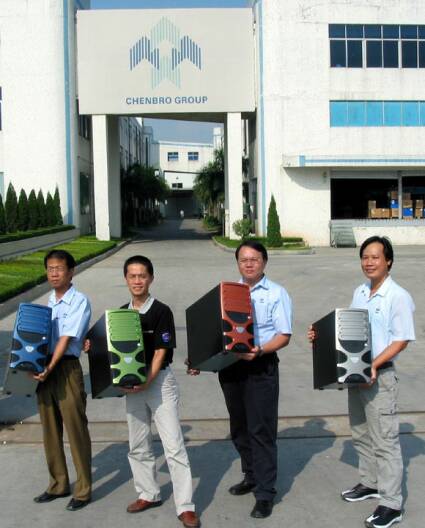China Dispatch: Adventures in Case Manufacturing
Conclusion: Almost 300 Steps To Build A Case... Who Would Have Thought?
After examining the nearly 300 steps required to build a single Chenbro case, needless to say we were amazed at Chenbro's time intensive and exacting process for case manufacturing. All of these steps are carefully sequenced and well performed and Chenbro has its quality controls almost "to a science" with the Xpider/Gaming Bomb.
Ken, Johnny, Kevin, and Jim pose for a photo holding the finished Xpider/Gaming Bomb cases in front of the Chenbro factory. The employees at this factory (and all of the Chenbro factory locations) are proud of the products they all help produce. While it was not possible to thank each employee in person, we want each of them to know that we were very impressed with their work ethic and the quality of work that they do.
We learned many things about computer case building during our time with Chenbro, and we will apply this knowledge in our future case reviews. We know that not all cases are created with high quality standards; companies that produce sub-standard cases in order to offer low prices will, unfortunately, continue to grab a large piece of the market. The difference between the hard tooling and soft tooling processes are more evident than ever when you examine the quality differences in manufactured cases. Only cases that are hard tooled offer the best levels of quality consistency from case to case. This does not mean that cases produced using soft tooling are inferior, but consistent quality is difficult to control with soft tooling; and the additional time and labor that is required to produce quality soft tooled cases means that manufacturers must charge more for cases made with the soft tooling process to cover their production costs. (We will be covering cases that are produced using soft tooling in future THG reviews.)
We extend our thanks to all of the employees of Chenbro, and especially to Ken Hong, who served as both guide and translator during our time producing this story. We were pleasantly surprised with the atmosphere of openness and the willingness of the Chenbro team to allow us to view even the smallest of details. It is not often that a company grants this broad access to a journalist without placing restrictions on what can and cannot be photographed and written about. Chenbro allowed us to see everything we requested and more, and provided in-depth answers to each question. We were very impressed with their level of professionalism.
No matter what you previously thought about the process of design, testing, development and manufacturing of computer cases, with the help of Chenbro we have learned much about the specifics of computer case production. We weren't really surprised that quality is the key factor in selecting a computer case for purchase; but we were surprised at how much effort goes into producing quality at Chenbro. Other case companies may offer rock bottom prices and/or try to sway your decisions based on the latest bells and whistles, but unless you buy a quality product you are wasting your money. The adage "Seeing is believing" rings very true in this instance. Without a quality controlled process products produced in quantity cannot be of consistent quality; this was never so obvious until we visited the Chenbro facility and saw this process ourselves.
Get Tom's Hardware's best news and in-depth reviews, straight to your inbox.
Current page: Conclusion: Almost 300 Steps To Build A Case... Who Would Have Thought?
Prev Page Final Assembly Process, Continued-
zhijunli Please visit more factories before you say "why others don't think that an inexpensive detail such as this is important."Reply -
Those guys been working with vendors that can supply vacuum deposited, electroplated, printed and spray painted plastic parts. This is old news..Reply
http://www.pa-international.com.au/index.php?option=com_content&view=article&id=127&Itemid=172
